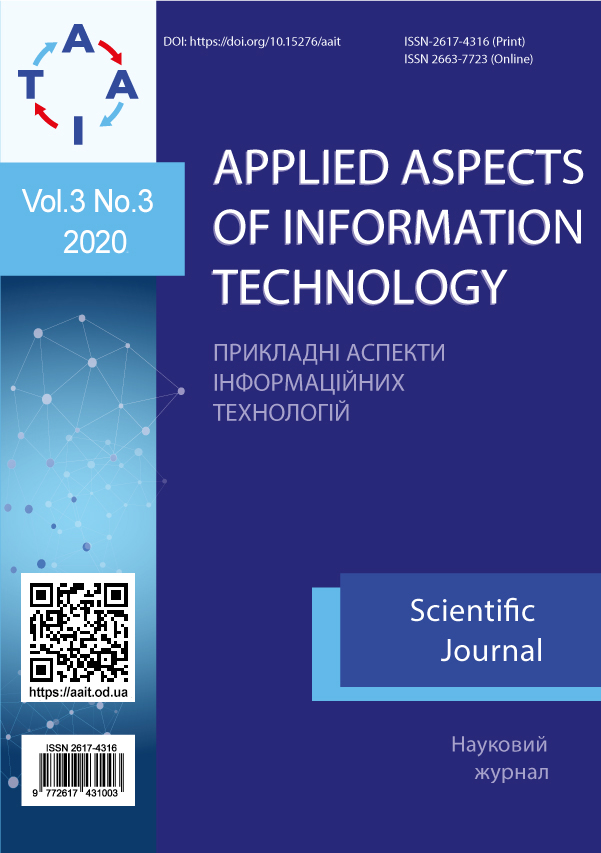Intelligent system based on a convolutional neural network for identifying people without breathing masks
Main Article Content
Abstract
Розроблено інформаційну технологію автоматизованої оцінки рівня зносу артилерійських стволів. Інформаційна технологія заснована на аналізі акустичних полів, які супроводжують постріл. Акустичне поле пострілу складається з балістичної хвилі, що супроводжує вилітаючий з надзвуковою швидкістю снаряд, і дульної хвилі, що утворюється при викиді зі стволу порохових газів. Параметри балістичної і дульної хвиль істотно залежать від рівня зносу стволу. Це дає можливість побудувати автоматичний класифікатор стволів за рівнем зносу на підставі аналізу інформативних ознак акустичних сигналів, зареєстрованих мікрофонами поблизу вогневої позиції гармати. В основу інформаційної технології покладено бінарний SVM-класифікатор. Синтезовано набір записів акустичних полів пострілів на основі реальних сигналів, зареєстрованих при стрільбі 155 мм гаубиці. З набору записів сформовані навчальна і тестова вибірка інформаційних ознак для навчання класифікатора і оцінки його якості. Досліджено методи попередньої нормалізації даних навчальної та тестової вибірок. Розроблено методику оптимізації гіперпараметрів класифікатора шляхом поекземплярної крос-валідації. Методика являє собою двоетапний пошук оптимальних значень гіперпараметрів. На першому етапі пошук здійснюється на експоненційній десяткової сітці. На другому етапі оптимальні значення гіперпараметрів уточняються на лінійній сітці. Сформульовано метод бінарної класифікації артилерійських стволів за рівнем зносу. Перевірка класифікатора на спроможній тестової вибірці показала, що він забезпечує правильну класифікацію зносу стволів з ймовірністю 0,94. Розроблено інформаційну технологію класифікації артилерійських стволів за рівнем зносу на підставі аналізу акустичних полів пострілів. Інформаційна технологія складається з трьох стадій: підготовка даних, побудова, навчання і оптимізація бінарного SVM-класифікатор і експлуатація бінарного SVM-класифікатор. Проведено польовий експеримент, що підтвердив правильність основних наукових і технічних рішень. Розроблено автоматизовану систему для класифікації стволів за рівнем зносуThe COVID-19 pandemic is having a huge impact on people and communities. Many organizations face significant disruptions and issues that require immediate response and resolution. Social distancing, breathing masks and eye protection as preventive measures against the spread of COVID-19 in the absence of an effective antiviral vaccine play an important role. Banning unmasked shopping in supermarkets and shopping malls is mandatory in most countries. However, with a large number of buyers, the security is not able to check the presence of breathing masks on everyone. It is necessary to introduce intelligent automation tools to help the work of security. In this regard, the paper proposes an up-to-date solution – an intelligent system for identifying people without breathing masks. The proposed intelligent system works in conjunction with a video surveillance system. A video surveillance system has a structure that includes video cameras, recorders (hard disk drives) and monitors. Video cameras shoot sales areas and transmit the video image to recording devices, which, in turn, record what is happening and display the video from the cameras directly on the monitor. The main idea of the proposed solution is the use of an intelligent system for classifying images periodically received from cameras of a video surveillance system. The developed classifier divides the image stream into two classes. The first class is “a person in a breathing mask” and the second is “a person without a breathing mask”. When an image of the second class appears, that is, a person who has removed a breathing mask or entered a supermarket without a breathing mask, the security service will immediately receive a message indicating the problem area. The intelligent system for image classification is based on a convolution neural network VGG-16. In practice, this architecture shows good results in the classification of images with great similarity. To train the neural network model, the Google Colab cloud service was used – this is a free service based on Jupyter Notebook. The trained model is based on an open source machine learning platform TensorFlow. The effectiveness of the proposed solution is confirmed by the correct processing of the practically obtained dataset. The classification accuracy is up to 90 %.



